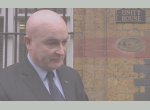Similar topics:
Attached documents
RMT Upfront is the newsletter for London Underground train drivers from the RMT. Please share the newsletter on social media or print it out and distribute it in your depot.
SATS vs Assisted Despatch
There is a big difference between the two issues; Assisted Dispatch covered in Rule Book 8, section 6, and Platform Duties covered in Rule Book 8, section 3. The important difference is that Platform duties ( SATs) is to assist with dwell times, get trains moving and to stop a train in an emergency using the same training provided to all our station staff. Whereby Assisted Dispatch is in place to assist the driver when they cannot see the Platform Train Interface (PTI) for any reason whether this is over-crowding on the platform or defective OPO equipment. You must only depart a platform when it is safe to do so; this is covered in Rule Book 6 sect 2.7!
The driver is ultimately responsible for the safe departure of the train and will be held accountable should anything happen as a result of their actions. Drivers across the entire network need to know this. It really is that simple! If you cannot see the PTI you should ask for an Assisted Dispatch. The station staff should assist you in departing safely.
This is even more important during the ongoing Station’s Dispute with LUL where managers are playing fast and loose with safety processes, especially during the recent strike where drivers were expected to drive through up to 11 unstaffed stations. When you add so called Ambassadors with two days training into the mix looking after our severely over – crowded platforms it’s like playing Russian Roulette with a bullet in every chamber.
Passenger numbers keep going up
Over the past 15 years, daily passenger journey numbers have increased from around three million per day to a record five million just before Christmas. So, what have LUL management done in those years to improve the safety of the PTI? The answer is not a lot! LUL have increased train numbers on upgraded lines and installed in - car CCTV on those lines. Unfortunately this doesn’t begin to address the current overcrowding on many of our stations. This is further exasperated by the current stations overtime ban which has highlighted the chronic shortage of station staff after the shambolic implementation of ‘Fit for Future Stations’ (FFFS) austerity programme.
Big Gaps in the GAPS Project
With the introduction of ‘S’ Stock on SSR, management conceded there were problems with the PTI. The RMT having been telling management for the past two years that there were also obscured PTI images on BCV and JNP.
Our warnings fell on death ears. Only following an incident at Clapham South where a dragging incident occurred, the ORR finally intervened. The result was the GAPS project.
This was originally designed to be a project that identifies the problems with PTI across BCV and JNP and address the issues. Yet, the only thing achieved so far is a number of stations have been identified as high risk.
LU have tested painting yellow lines on a few platforms in different ways. They are now talking about using under platform lighting at some locations, but this is the mitigation that was no use on SSR.
What has been accomplished? In essence, not a lot! This notice is the only way we can advise our members to protect themselves and indeed the travelling public.
There are 46 platforms out there that have been identified as at risk and many have been simply ignored by this piece of work. For further information on these location ask your local Safety Rep or any member of your Train’s Safety Council.
You are responsible for the safe movement of your train
In recent years there have been a number of incidents across the country where there have been incidents where criminal charges are brought against Train Drivers accused of not being diligent in performing train dispatch.
The most frightening case comes from a ‘Mersey rail’ case where an elderly lady tried to board a train after the doors closing warnings were made and ignored. Mersey rail and indeed the Office of Road and Rail (ORR) found the driver had acted according to the rules and there was no case to answer.
Unfortunately, the BTP and the Crown Prosecution Service saw things differently and brought charges against the driver. The driver is still awaiting the outcome of this case. This scenario highlights the importance of drivers being diligent and acting in accordance with the Rule Book at the PTI. Your job and your liberty could depend upon it.
Upfront January 2017 Final by RMT London Calling on Scribd
- 3099 reads






